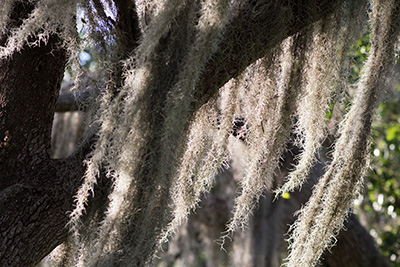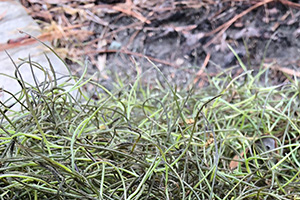Spanish Moss
Spanish moss is a trademark of the South. You’ll find this tangled-looking, gray or green bromeliad draped across oaks, fences, and telephone lines throughout Florida.

Contrary to popular belief, Spanish moss (Tillandsia usneoides) is not a moss and although it grows on trees, it’s not a parasite, either. Spanish moss is actually a flowering epiphyte, meaning it is a plant that grows on other plants for support and to access sunlight. Epiphytes get all of their nutrients from the air and rainwater.
Rather than roots, Spanish moss uses specialized scales to collect the moisture and nutrients it needs to survive from the air, rainwater, and from debris that lands on it. It’s commonly found on trees in Florida like live oak and cypress, but it can also grow on other trees like crapemyrtle, pines, sweetgum, other plants, and stationary items like fences and telephone poles. Spanish moss prefers moist environments but can survive in extreme temperatures and dry conditions by trapping water or going dormant until moisture conditions improve. And while you’ve probably never noticed, Spanish moss flowers, typically producing a single greenish and fragrant flower in the spring, usually around April.
It actually has an important role in Florida’s ecology, and is useful to both wildlife and humans. Many animals use Spanish moss for protection, taking cover in the thick masses. Two species of bats use garlands of Spanish moss as daytime resting sites. Zebra longwing butterflies roost in it at night. Spanish moss is also a significant component of the nests of several species of birds, including the Parula warbler and the Baltimore oriole.
Insects love to hide out in the moss, too. It’s common to find chiggers in Spanish moss that’s lying on the ground (not moss on trees), so be careful when handling it because contact with chiggers can result in bites and uncomfortable welts.

Historically, Spanish moss was harvested for use as a stuffing material in things like mattresses, automobile seats, furniture, and insulation in homes. It’s still used in floral arrangements, and less commonly as mulch and sold online as a specialty plant.
Spanish moss is easily recognizable for its long, curling stems. It’s very drought tolerant, dormant and gray until rains come, when it takes on a greenish hue as it absorbs the water.
An unfair characterization
Spanish moss does not need to be removed from your trees because it does not kill trees. Homeowners will sometimes see a heavy covering of Spanish moss on a tree and blame it for the decline of the tree. However, it is much more likely that another culprit is to blame for the declining health of the tree; increased growth of Spanish moss is the result of more sunlight from the thinning canopy of the unhealthy tree. Of course, lots of moss on a tree can negatively impact the tree by shading the leaves, slowing growth, and breaking branches, but for healthy trees, the impact is minimal.
If you’re concerned about Spanish moss in your tree, consult with an ISA certified arborist. These professionals can assess the health and structure of your tree and determine if moss removal is justified. Be aware that it will likely grow back so you won’t be moss-free forever.
So be a good host and let your Spanish moss hang out in your yard.
